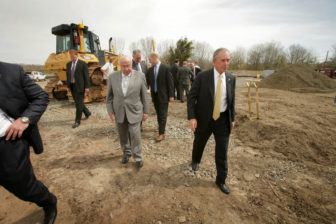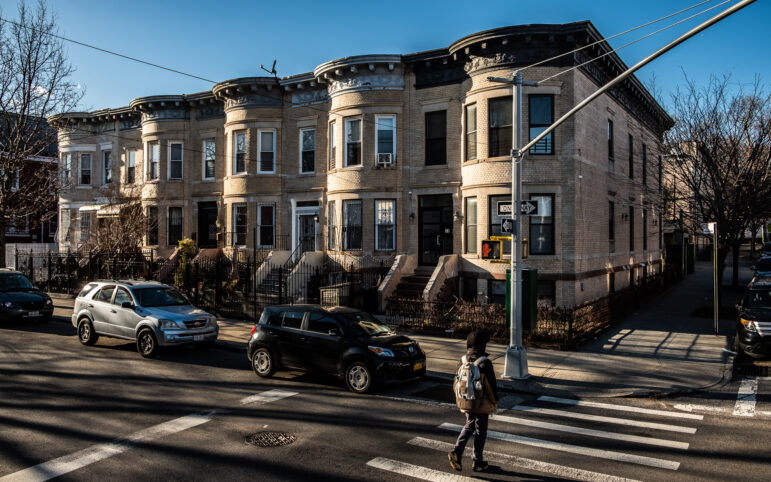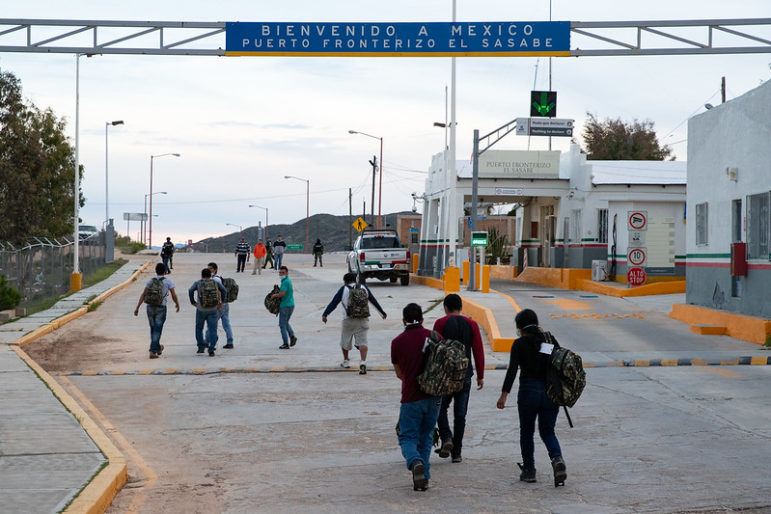(Page 2)
Staten Island needed the downzoning to protect its overtaxed infrastructure. And Molinaro says it wasn’t popular with all Staten Islanders: Some landowners were furious that they could no longer develop at the same density levels.

Photo Credit: Edward Reed
Then-Borough President James Molinaro, in the grey suit, with Mayor Bloomberg of the island in 2010. Bloomberg’s support for the 2004 rezoning had clear political benefits but the former BP says it also responded to real needs on the island.
Molinaro also continues to defend the downzoning against those, like Lander, who argued Staten Island could have done more of its fair share of absorbing population density. Although the city has invested hundreds of millions of dollars over the past couple decades to upgrade the borough’s sewer infrastructure, Molinaro says that prepping the borough for a larger population would require a fortune more—to upgrade sewer and gas infrastructure, widen streets to comply with fire fighting codes, put power lines under ground, and create a more robust transportation system.
“When you don’t know the total problems, then there’s merit to it,” he says of Lander’s argument.
But he says he’s always recognized that the North Shore, which is well served by the ferry and has always been more pedestrian-friendly, provided opportunities for growth. Knowing that the New York Wheel and Empire Outlets were in the cards, he worked with Burden to explore opportunities for development in the area. One of the outcomes of their work was the 2008 Special St. George District Rezoning, affecting a small part of the North Shore. It allowed modest density increases designed not to block the views of the harbor from residencies on the hills, with new regulations to encourage commercial storefronts on ground floors and a friendlier pedestrian environment.
Saving the birds and the trees
In the years that followed the 2004 downzoning, Staten Island’s growth did slow down, though it’s hard to tell exactly how much was caused by the rezoning.
Staten Island’s population grew only 5.6 percent over the following decade, but the city’s overall growth rate slowed down greatly as well, and Staten Island’s growth rate slowed down only slightly more than the others, and was still the highest among the five boroughs.
The data on housing units is a little more notable. While in 2000 there were over 3,000 certificates of occupancy issued for Staten Island, the second highest among the boroughs, in 2015 there were less than 500 issued, leaving Staten Island by far the most quiet.
City Limits spoke with six Staten Island residents, among them three real estate industry professionals, two neighborhood association presidents, and a former community-board chair, who spoke of the 2004 rezoning as a necessity and as a success, though some noted that there were still some areas with outsized development that, in their opinion, needed better controls. (And some neighborhoods, like Westerleigh, did get a somewhat more reluctant Amanda Burden to grant them an even stronger downzoning.) Many saw the rezoning as having a good effect on the property values of Staten Island homes.
on the proposed new
Bay Street
rezoning
In actuality, median sales prices for single-family homes did rise, but pretty much on pace or even less than they did citywide. According to data from the NYU Furman Center, in 2000, the average Staten Island home sold for about $302,000, while the average New York City home sold for $314,000. By 2015, that average Staten Island home sold for $403,000, while the average New York City home sold for $460,000. This is fairly consistent with historical trends, too: Staten Island’s housing prices grew at a slower pace than the rest of the city during the 1980s housing boom too. And there’s a variety of factors beyond zoning that could have made an impact here: Staten Island had to survive the devastation of Hurricane Sandy. A national trend toward urban living may also have increased the demand for more centrally located homes in other boroughs.
David Gerts, a Staten Island resident and real-estate broker who sells homes in several boroughs, says he believes downzoning does have the effect of keeping a lid on housing prices, with land values falling as multifamily developers lose interest. It’s the sacrifice, he says of getting to “see trees and hear birds and even once and a while have a deer pass by.”
The costs of a slow down
There are costs to downzonings, however, that not everyone talks about.
The Reverend Janet Jones of Rossville AME Zion Church on the South Shore recalls her church’s efforts to develop affordable senior rental apartments on a parcel of vacant land owned by the church.
This was in 2008, after the 2004 borough-wide downzoning, but existing zoning for the plot still allowed the African Methodist Episcopal church to build a four-story residential building. The church still needed some approvals for construction, however, and were faced with virulent animosity from other South Shore residents that sometimes took on racial overtones, with one man calling the proposed senior housing “projects” and some people asking, Jones recalls, “what kind of people are going to be living in these buildings?” The South Shore is 93 percent white, according to the 2010-2012 census.
In 2010, State Senator Andrew Lanza, accusing the church of harboring greed for profit, sponsored another downzoning for the neighborhood that prohibited townhouses, putting the kibosh on the church’s project. Jones still mourns the loss of an opportunity to meet the neighborhood’s need for affordable senior housing. While she sees that downzonings, like the 2004 Low Density Growth Management Zone, can be a useful tool to limit overcrowding and traffic, she says the church’s project would have included off-street parking and would not have burdened the neighborhood.
In the broad picture, it’s hard to say how much Staten Island’s multiple downzonings might have contributed to the city’s affordability crisis. Not every townhouse that never got built would have been affordable, but some argue that reducing the overall supply of housing in the city creates competition for existing units, raising prices in the city overall. On the flip side, it’s possible, though not proven, that the downzoning actually helped to slow rent growth in Staten Island. According to data from the Furman Center, from 1996 to 1999, median monthly rents for Staten Island’s three community districts grew between $20 and $50. Again from 1999 to 2002, Staten Island’s median rent increased by $13, roughly on pace with city averages. Yet from 2006 to 2014, Staten Island’s median rent decreased by $19, while increasing $162 in the city as a whole.









11 thoughts on “13 Years After Blocking New Development, Staten Island Hopes to Welcome Just Enough of it”
Interesting synopsis of development and how it is regulated on Staten Island, though I question the use of the word “welcome” in your headline. Maybe Staten Islanders are willing to tolerate just enough development.
S.I. current population is 474,558. There really is no practical way to accommodate large increases in population for the reasons stated in my post of 3/14/17. Why does every part of the city have to be a crowded mess? S.I. and eastern Queens are among the few areas where a middle-class New Yorker can buy a 1 or 2 family home. Approx 67% of Staten Islanders are homeowners. In the others 4 boroughs an average of 72% are renters. NYC renters put up with a lot of abuse but homeowners care more about their home community because they have the significant financial investment of their home.
Agreed on all points, thanks for stating the situation simply.
The downzonings had been desired by east shore and south shore SI residents for years. Staten Island as a limited road infrastructure with no true street grids as in the other boroughs. Our arterial road network is still pretty much what the Dutch and British left us. That’s one of the reasons our local bus network is so difficult to change.
We of course don’t have a subway connection and never will. So it’s either the ferry or the express bus to Manhattan. And we can’t get the MTA to increase express bus service or add new express routes. The S.I. Expressway and the Verrazano Narrows Bridge are at or near capacity. So that express bus ride eats up more time every year.
S.I. is served by two 60 year old water/sewer treatment plants. The related water/sewer mains were installed over the last 75 years for a much smaller S.I. Even a few new high rises on the north shore will dangerously stress that system.
Staten Islander don’t want to hear about this ‘Fair Share’ nonsense. For 54 years we shouldered the Fresh Kills garbage dump. Today even simple things like getting a new traffic signal are blocked by the city.
I live in one of the downzoned areas of the east shore. I don’t see that it impacted property values either way. Homes sell quickly in my area because it’s an established desirable area of mostly 1-family homes and is near the Hylan Blvd express buses and shopping centers.
Yes, you give a very accurate assessment of Staten Island’s situation.
We want to be left alone.
Exactly, we like living under the radar in our safe quiet neighborhoods.
Go back and look at the plans Robert Moses had for Staten Island. Never came to fruition though. Those parkways would have taken traffic off the inadequate local roads.
True about the Richmond Parkway and Shore Front Parkway. Will never happen but the state should complete the Richmond Parkway all the way to the Staten Island Expressway. Forget about the Shore Front Parkway. Moses acquired the land for it but it never got off the drawing board.
So on the one hand people want downzoning because it increases property values, yet on the other hand upzoning is bad because it increases property values. Huh?
Pingback: Center for Community and Ethnic Media – Ippies 2018 Winners Announced
Pingback: Center for Community and Ethnic Media – CCEM to ‘Broaden Its and Reach and Focus on the National Horizon’